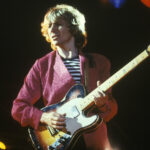Guitar Pedals, often called stompboxes or effects units, are essential tools for guitarists and bassists seeking to sculpt their unique sound. These compact devices sit conveniently on the floor or a pedalboard, allowing musicians to engage and disengage effects with a simple foot tap. Typically, a guitar pedal is dedicated to a single effect, offering a focused approach to sound manipulation. The most basic stompboxes feature a footswitch for on/off control, a few knobs (potentiometers) to adjust effect parameters like gain or tone, and an LED indicator to show activation status. More advanced pedals can boast multiple footswitches, a wider array of knobs and switches, and even digital displays to provide detailed information about the effect and its settings.
Connecting several guitar pedals together creates what’s known as an effects chain or signal chain. This arrangement is fundamental to crafting a personalized and distinctive guitar tone. The order in which pedals are connected plays a crucial role in the final sound. Perhaps the most ubiquitous type of guitar pedal is the distortion or overdrive pedal. These pedals add harmonic richness and sustain, ranging from subtle warmth to aggressive crunch, driving the guitar signal into the amplifier to produce tones favored across numerous music genres. Beyond distortion, a wide spectrum of guitar pedals exists, each offering unique sonic textures. Popular examples include the wah-wah pedal, which creates a vocal-like sweeping effect; fuzz pedals for thick, saturated distortion; delay and reverb pedals for adding depth and spaciousness; and modulation pedals like flanger, phaser, and chorus to create swirling and shimmering effects. Many players also incorporate EQ pedals to fine-tune their frequency response and compression pedals to even out dynamics and increase sustain. The sheer variety of brands and effects available makes the possibilities for sonic exploration with guitar pedals virtually limitless.
To maintain tonal clarity and prevent unwanted muddiness, a general guideline for signal chain order is often followed. Compression, wah, and overdrive pedals are typically placed at the beginning of the chain, closest to the guitar. Modulation effects like chorus, flanger, and phaser are commonly positioned in the middle. Time-based effects such as delay, echo, and reverb are usually placed towards the end of the chain, just before the signal reaches the amplifier. When using multiple guitar pedals, it’s common to encounter unwanted noise or hum in the guitar signal. To combat this, many musicians employ a noise gate or noise suppressor pedal. These pedals can be placed either at the beginning or end of the effects chain to effectively reduce extraneous noise and hum, ensuring a cleaner and more focused guitar tone.

